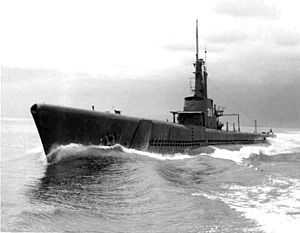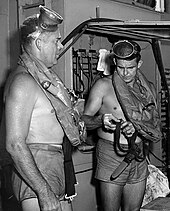USS Archerfish (SS-311)
 USS Archerfish (SS-311)
| |
| History | |
|---|---|
| Namesake | Archerfish |
| Builder | Portsmouth Naval Shipyard, Kittery, Maine[1] |
| Laid down | 22 January 1943[1] |
| Launched | 28 May 1943[1] |
| Commissioned | 4 September 1943[1] |
| Decommissioned | 12 June 1946[1] |
| Badge |  |
| Recommissioned | 6 March 1952[1] |
| Decommissioned | 21 October 1955[1] |
| Recommissioned | 1 August 1957[1] |
| Decommissioned | 1 May 1968[1] |
| Stricken | 1 May 1968[2] |
| Fate | Sunk as a target off California on 19 October 1968[2] |
| Badge |  |
| General characteristics | |
| Class and type | |
| Displacement | 1,526 tons (1,550 t) surfaced,[2] 2,391 tons (2,429 t) submerged[2] |
| Length | 311 ft 9 in (95.02 m)[2] |
| Beam | 27 ft 3 in (8.31 m)[2] |
| Draft | 16 ft 10 in (5.13 m) maximum[2] |
| Propulsion |
|
| Speed | 20.25 kn (37.50 km/h) surfaced,[3] 8.75 kn (16.21 km/h) submerged[3] |
| Range | 11,000 nmi (20,000 km) at 10 kn (19 km/h) surfaced[3] |
| Endurance | 48 hours at 2 kn (3.7 km/h) submerged,[3] 75 days on patrol |
| Test depth | 400 ft (120 m)[3] |
| Complement | 10 officers, 70–71 enlisted[3] |
| Armament |
|
USS Archerfish (SS/AGSS-311) was a Balao-class submarine. She was the first ship of the United States Navy to be named for the archerfish. Archerfish is best known for sinking the Japanese aircraft carrier Shinano in November 1944, the largest warship ever sunk by a submarine. For this achievement, she received a Presidential Unit Citation after World War II.
Construction and commissioning
Archerfish's
World War II
Archerfish underwent shakedown training through the first part of November off the New England coast, and headed for Hawaii via the Panama Canal. She arrived at Pearl Harbor on November 29, 1943 and joined the Pacific Fleet.
First four patrols, December 1943 – September 1944
After receiving voyage repairs and undergoing training exercises, Archerfish got under way on December 23, for her first war patrol. She paused at Midway Atoll on December 27, to refuel before proceeding to her patrol area north of Taiwan. During this patrol, she attacked three ships, but scored no kills before returning to Midway on February 16, 1944 for repairs and training.
The submarine stood out of Midway on March 16, 1944 on her second war patrol but encountered no Japanese targets during her 42 days at sea, mostly near the
A month and a day later, Archerfish left Pearl Harbor, bound for the Bonin Islands area and her third patrol. She was assigned lifeguard duty during the strikes against Iwo Jima on July 4, and rescued downed aviator Ensign John B. Anderson before returning to Midway on July 15.
After a refit alongside
Fifth patrol, October–December 1944: Sinking Shinano
Archerfish left Hawaii on October 30, under the command of

Enright ordered the carrier tracked from ahead in preparation for an attack from below. After six hours, the enemy carrier turned back into Archerfish's path, and Archerfish got into an attack position. Archerfish submerged and fired six torpedoes, four of which found their mark. Enright deliberately set the torpedoes to run shallow (10 ft or 3 m) in hopes of capsizing the target by holing it higher up on its hull. He also wanted to increase the chances of a hit in case the torpedoes ran deeper than set. Before Archerfish descended to 400 ft (120 m) to avoid a depth charge attack, Enright saw that the carrier was listing to starboard. The crew began picking up loud breaking-up noises from the target shortly after firing the last torpedo. The noises continued for 47 minutes.
The patrol ended at Guam on December 15, after 48 days on station. Initially, the Office of Naval Intelligence thought that Archerfish had sunk a cruiser, not believing that there were any carriers in that stretch of ocean. However, Enright had made sketches of the target, and Archerfish was given credit for sinking a 28,000-ton carrier.
It was only after the war that the Americans learned the identity of Archerfish's quarry:
Last two patrols, January–September 1945
While her officers and crew spent the holidays at a rest and recreation camp located on Guam, Archerfish underwent refit at the island. On January 10, 1945, the submarine got underway for her sixth patrol. Enright was in command of "Joe's Jugheads", a three-submarine "wolfpack" comprising Archerfish, Batfish, and Blackfish.[10] This mission took her to waters in the

Following completion of the yard work, Archerfish sailed on June 14, for
Post-war
The submarine left Pearl Harbor on January 2, 1946, bound for San Francisco. From January 8, to March 13, the ship's force carried out her preinactivation overhaul. On the latter day, she proceeded to the Mare Island Naval Shipyard where the final stages of inactivation were completed. Archerfish was decommissioned on June 12, 1946 and placed in the Pacific Reserve Group berthed at Mare Island.
1952–1955
During the
With repairs complete on May 27, Archerfish held shakedown off the West Coast. She then transited the
Oceanographic work, 1958–1964
Archerfish was reactivated at New London in July 1957, placed back in commission on August 1, and again joined SubRon 12 at Key West. On January 13, 1958, she got underway for a cruise under the technical supervision of the Navy Hydrographic Office. On this deployment, she visited Recife, Brazil, and Trinidad. Upon completion of that mission she provided services for the fleet training commands at Key West and Guantánamo Bay. (In this time, she also portrayed the USS Sea Tiger in the 1959 movie Operation Petticoat for the underwater and distance scenes and shots.)

On October 2, 1959, approximately 15 miles southwest of Key West, over Vestal Shoal, Archerfish bottomed at 322 feet (98 m). Commander George F. Bond and Chief Engineman Cyril Tuckfield safely completed a 52-second, 302-foot buoyant ascent from the forward escape trunk. Both men received the Legion of Merit in 1960 for establishing the feasibility of deep submarine escape by locking out.[12]
In early 1960, Archerfish was chosen to participate in Operation "Sea Scan", a scientific study of marine weather conditions, water composition, ocean depths, and temperature ranges. She entered the
After six weeks of upkeep, Archerfish got underway on January 20, 1961 for the Pacific phase of "Sea Scan", transited the
Phase two of Operation "Sea Scan" continued during the early months of 1962 with operations in the western Pacific area and port calls at
Archerfish departed San Diego on January 10, 1963, bound for Yokosuka, where she began a three-week upkeep period. Following two and one-half months of operations she returned to the United States for a brief visit to
Departing Pearl Harbor on March 30, the ship continued "Sea Scan" operations in the eastern Pacific. She visited San Francisco in April and Vancouver, in May before returning to Pearl Harbor on May 25, ending the third phase of "Sea Scan".
Archerfish began an extended fourth and final phase of Operation "Sea Scan" when she left Pearl Harbor on June 17, and headed for the eastern Pacific. She made port calls during July at Seattle and Olympia, Washington, and returned to Pearl Harbor on August 19, for a three-week upkeep and drydocking before undertaking a cruise to the South Pacific. The submarine sailed on September 9, for the Fiji Islands. After briefly touching Suva, she headed for Auckland, New Zealand, for an 11-day visit. Her next stop was Wellington, New Zealand, but she left New Zealand on October 19, and arrived in Yokosuka on November 6. She got underway again on November 27, to continue survey operations in the Caroline Islands area. After spending New Year's Eve in Guam, the ship sailed for Subic Bay, Philippines, where she closed the year in upkeep.
1965–1968
During the remaining three and a half years of her Navy career Archerfish carried out various research assignments in the eastern Pacific. In early 1968, Archerfish was declared unfit for further naval service and was struck from the Naval Vessel Register on May 1, 1968. She was towed to a target position off San Diego and sunk by a torpedo fired from the submarine Snook (SSN-592) on October 19, 1968.[10]
Awards
 Presidential Unit Citation
Presidential Unit Citation- battle stars for World War IIservice
 Navy Occupation Service Medal with "ASIA" clasp
Navy Occupation Service Medal with "ASIA" claspReferences
- ^ ISBN 1-55750-263-3.
- ^ ISBN 0-313-26202-0.
- ^ a b c d e f U.S. Submarines Through 1945 pp. 305–311
- ^ ISBN 978-0-313-26202-9.
- ^ U.S. Submarines Through 1945 pp. 261–263
- ^ U.S. Submarines Through 1945 pp. 305–311
- ^ Tully, Anthony P.; Jones, Matthew; Stone, Randy; Kingsepp, Sander (2012). "IJN Shinano: Tabular Record of Movement". combinedfleet.com. Retrieved 8 July 2020.
- ^ Toda, Gengoro S. "第二百四十一號驅潜特務艇の艦歴(No. 241 submarine chaser - Ship History)". Imperial Japanese Navy -Tokusetsu Kansen (in Japanese).
- ^ Reports of the US Naval Technical Mission to Japan, Ship and Related Targets Archived 18 October 2013 at the Wayback Machine
- ^ a b Cornelison, G.L. (5 June 2010). "The History of the U.S.S. ARCHERFISH (SS/AGSS-311)". Retrieved 9 June 2010.
- ^ U boat netforum USS Archerfish
- ISSN 0889-0242.
 This article incorporates text from the public domain Dictionary of American Naval Fighting Ships. The entries can be found here and here.
This article incorporates text from the public domain Dictionary of American Naval Fighting Ships. The entries can be found here and here.- Keith, Don; Henry, Ken (2006). Gallant Lady: A Biography of the USS Archerfish. Tom Doherty Associates. ISBN 978-0-7653-0569-5.
External links
- Photo gallery of Archerfish at NavSource Naval History
- Official website: USS Archerfish
- Kill Record: USS Archerfish
